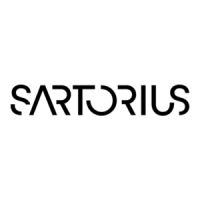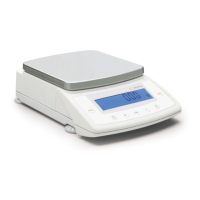Do you have a question about the Sartorius CPA223S and is the answer not in the manual?
General safety instructions for operating the balance and preventing damage.
Electrical safety and cable connection precautions.
Guidelines for safe storage and transport of the balance.
Steps for unpacking and inspecting the balance for damage.
Site selection and acclimation process for the balance.
Details on the control seal for verified balances.
Guide for assembling CPA2P model components.
Guide for assembling CPA2P-F model components.
Instructions for positioning and securing the draft shield.
Necessary warm-up periods for accurate measurements.
Procedure for securing the balance with an antitheft lock.
Step-by-step leveling for lower capacity models.
Step-by-step leveling for higher capacity models.
Explanation of the balance's interface and buttons.
Core functionality for weighing and taring.
Specific handling for microbalance models.
Instructions for using the port for suspended weighing.
Distinguishing between calibration and adjustment.
Requirements for verified balances in legal metrology.
Step-by-step guide for internal calibration.
Step-by-step guide for external calibration.
Specific temperature ranges for verified units.
How to access and navigate the configuration menu.
Method for printing current balance configurations.
Guide to changing balance settings using codes.
Reference chart for available parameter settings.
Customizing measurement identifiers and display.
Using F and CF keys for program control.
Detailed guide for the net-total formulation feature.
Detailed guide for the counting feature.
Detailed guide for the weighing in percent feature.
Detailed guide for weighing unstable samples.
How to switch between different measurement units.
Capabilities and formatting options for printouts.
Generating compliant records for quality assurance.
Information included in GLP records.
Configuring printout options.
Connecting to external devices.
Commands for controlling the balance via computer.
Detailed pinout for the interface connector.
Visual guide for connecting cables.
Structure of commands sent to the balance.
How characters control balance functions.
Specification of the 25-pin connector.
Specification of the male connector used.
Caution regarding incorrect cable wiring.
Comprehensive list of pin functions.
Common issues, their causes, and resolution steps.
Details on maintenance contracts and repair services.
How to clean the balance and its parts.
Periodic checks for safe operation.
Technical details for CPA2P and CPA2P-F models.
List of optional products for the balance.
Regulations and directives for weighing instruments.
Sartorius services for metrological verification.
Details on CE marks, metrology seals, and model designation.
| Maximum Capacity | 220 g |
|---|---|
| Readability | 0.001 g |
| Linearity | ± 0.002 g |
| Display | LCD |
| Operating Temperature | +10°C to +30°C |
| Repeatability (Standard Deviation) | 0.001 g |
| Pan Size | 90 mm |
| Interface | RS-232 |
| Power Supply | AC adapter |
| Units | g, mg, oz |











